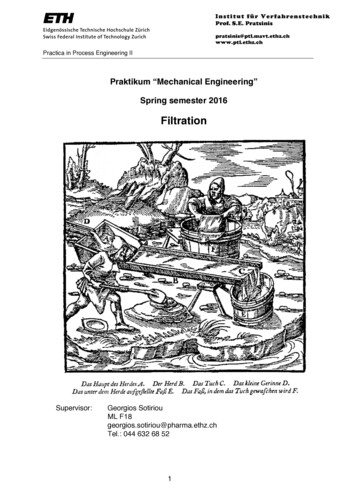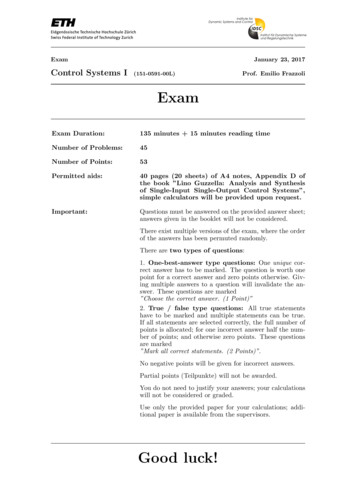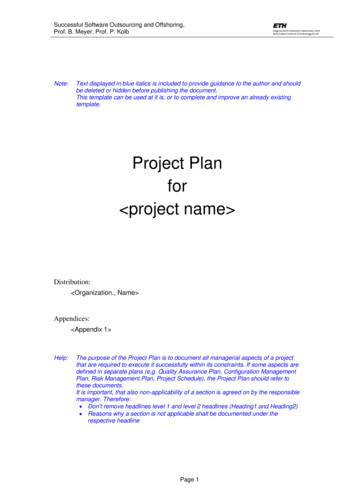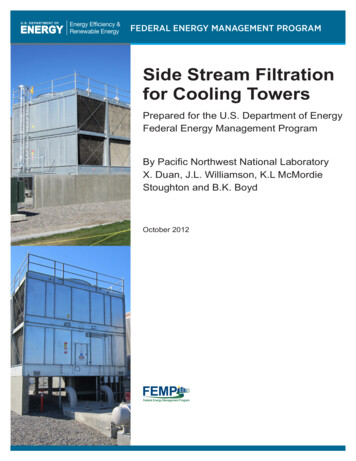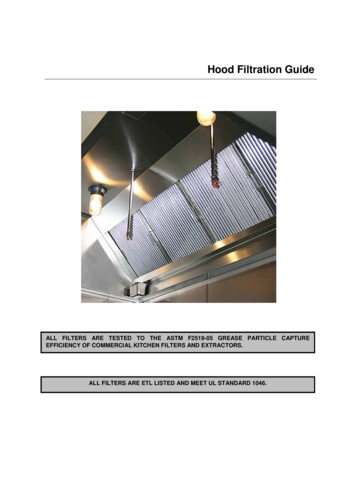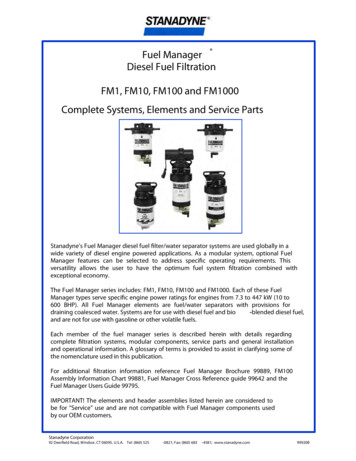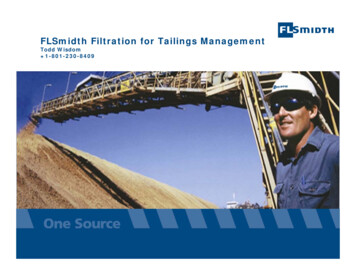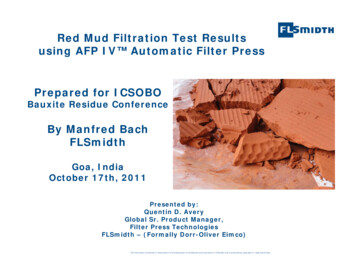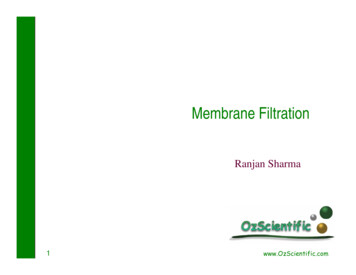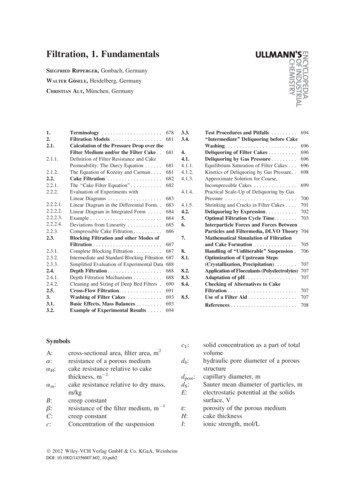
Transcription
Article No : b02 10Filtration, 1. FundamentalsSIEGFRIED RIPPERGER, Gonbach, GermanyWALTER G oSELE, Heidelberg, GermanyCHRISTIAN ALT, M unchen, .3.2.4.2.4.1.2.4.2.2.5.3.3.1.3.2.Terminology . . . . . . . . . . . . . . . . . . . . .Filtration Models . . . . . . . . . . . . . . . . . .Calculation of the Pressure Drop over theFilter Medium and/or the Filter Cake . .Definition of Filter Resistance and CakePermeability: The Darcy Equation . . . . . .The Equation of Kozeny and Carman . . . .Cake Filtration . . . . . . . . . . . . . . . . . . .The ‘‘Cake Filter Equation’’ . . . . . . . . . . .Evaluation of Experiments withLinear Diagrams . . . . . . . . . . . . . . . . . . .Linear Diagram in the Differential Form. .Linear Diagram in Integrated Form . . . . .Example . . . . . . . . . . . . . . . . . . . . . . . . .Deviations from Linearity . . . . . . . . . . . .Compressible Cake Filtration . . . . . . . . . .Blocking Filtration and other Modes ofFiltration . . . . . . . . . . . . . . . . . . . . . . . .Complete Blocking Filtration . . . . . . . . . .Intermediate and Standard Blocking FiltrationSimplified Evaluation of Experimental DataDepth Filtration . . . . . . . . . . . . . . . . . . .Depth Filtration Mechanisms . . . . . . . . . .Cleaning and Sizing of Deep Bed Filters .Cross-Flow Filtration. . . . . . . . . . . . . . .Washing of Filter Cakes . . . . . . . . . . . .Basic Effects, Mass Balances . . . . . . . . .Example of Experimental Results . . . . 0691693693694SymbolsA:a:aH :a m:B:b:C:c:cross-sectional area, filter area, m2resistance of a porous mediumcake resistance relative to cakethickness, m 2cake resistance relative to dry mass,m/kgcreep constantresistance of the filter medium, m 1creep constantConcentration of the suspension 2012 Wiley-VCH Verlag GmbH & Co. KGaA, WeinheimDOI: 10.1002/14356007.b02 10.pub24.1.5.4.2.5.6.8.8.1.8.2.8.3.8.4.8.5.Test Procedures and Pitfalls . . . . . . . . .‘‘Intermediate’’ Deliquoring before CakeWashing. . . . . . . . . . . . . . . . . . . . . . . . .Deliquoring of Filter Cakes . . . . . . . . . .Deliquoring by Gas Pressure . . . . . . . . .Equilibrium Saturation of Filter Cakes . . .Kinetics of Deliquoring by Gas Pressure. .Approximate Solution for Coarse,Incompressible Cakes . . . . . . . . . . . . . . .Practical Scale-Up of Deliquoring by GasPressure . . . . . . . . . . . . . . . . . . . . . . . . .Shrinking and Cracks in Filter Cakes . . . .Deliquoring by Expression. . . . . . . . . . .Optimal Filtration Cycle Time. . . . . . . .Interparticle Forces and Forces BetweenParticles and Filtermedia, DLVO TheoryMathematical Simulation of Filtrationand Cake Formation . . . . . . . . . . . . . . .Handling of ‘‘Unfilterable’’ Suspension .Optimization of Upstream Steps(Crystallization, Precipitation). . . . . . . .Application of Flocculants (Polyelectrolytes)Adaptation of pH . . . . . . . . . . . . . . . . . .Checking of Alternatives to CakeFiltration . . . . . . . . . . . . . . . . . . . . . . . .Use of a Filter Aid . . . . . . . . . . . . . . . . 07707707References . . . . . . . . . . . . . . . . . . . . . . . 708c V:dh :dpore:dS :E:e:H:I:solid concentration as a part of totalvolumehydraulic pore diameter of a porousstructurecapillary diameter, mSauter mean diameter of particles, melectrostatic potential at the solidssurface, Vporosity of the porous mediumcake thicknessionic strength, mol/L
678Filtration, 1. FundamentalsJ:KH:Km:KN:k:L:l:m:mi:N:n:h:p L:pS :Dp:pc:pce:pci:q:r:rD:SR:S:S v:S :treg:Q:U c:V:V:V/A:zi:z:Y:Boucher’s filterability index, m 3proportionality volume of cake/volumeof filtrate, m3/m3proportionality mass of cake/volume offiltrate, kg/m3proportionality number of particles/volume of filtrate, m 3permeability of the filter cake ¼ 1/aH,m2distance from the inlet face of the filterbed, mfilter coefficient of deep bed filters, m 1mass of dry filter cake, kgmolar concentration of ion ‘‘i’’, mol/Lnumber of open porescompressibility factorviscosity, Ns/m2pressure in the liquid, Pacompressive stress on the solids, Papressure dropcapillary pressure, Pacapillary entry pressure, Pacapillary suction pressure, Paexponent describing blocking behaviordistance from the solids surface, mDebye length, mreduced saturationsaturation (volume of liquid/volume ofpores)specific inner surfaceirreducible saturationregeneration time for cleaning and preparing a run, sdimensionless timeconsolidation ratevolume of filtrate, m3volumetric flow rate, m3/hspecific flow rate or filtration velocityvalency of ion ‘‘i’’surface potential, Venergy potentialIndicesav:e:H:L:averageend of filtrationrelated to cake thickness (height)liquidVol. 14loc:m:N:S:w:pore:localrelated to cake massnumbersolidwash liquorpore (volume)1. TerminologyFiltration is the separation process of removingsolid particles, microorganisms or droplets froma liquid or a gas by depositing them on a filtermedium also called a septum, which is essentiallypermeable to only the fluid phase of the mixturebeing separated. The particles are depositedeither at the outer surface of the filter mediumand/or within its depth. The permeation of thefluid phase through the filter medium is connected to a pressure gradient.This chapter deals only with filtration processes of solid–liquid mixtures (suspensions, slurries,sludges). For the treatment of gases by filtrationsee ! Dust Separation.Sometimes, however, purification of a liquidor gas is called filtration even when no semipermeable medium is involved (as in electrokineticfiltration).The liquid more or less thoroughly separatedfrom the solids is called the filtrate, effluent,permeate or, in case of water treatment, cleanwater. As in other separation processes, theseparation of phases is never complete: Liquidadheres to the separated solids (cake with residual moisture) and the filtrate often contains somesolids (solids content in the filtrate or turbidity).The purpose of filtration may be clarificationof the liquid or solids recovery or both. In clarification the liquid is typically a valuable productand the solids are of minor quantity and are oftendiscarded without further treatment. If however,the solids are to be recovered, they very oftenhave to be washed, deliquored and dried (seeFig. 1). In this article, washing means thecleaning of a product (filter cake) and it isdistinguished from cleaning parts of the filteritself, which will be called rinsing (e.g., rinsinga filter screen or a filter cloth by jets of water). Afurther distinction is to be made between washingand extraction or leaching. Washing eliminatesliquid contaminants from the pores between the
Vol. 14Filtration, 1. Fundamentals679Figure 1. Solids processing chainparticles of a filter cake. Extraction recoverssoluble matter out of the solid particles themselves (! Liquid–Solid Extraction). The termdrying means thermal drying, while the elimination of liquid from the filter cake by mechanicalforces is called deliquoring or dewatering, e.g.,deliquoring by a pressurized gas or by expression.Filtration processes can be classified in accordance with different criteria:1. Location of particle retentionThe particles can be separated on the outersurface of the filter medium (surface filtration, cake filtration) or inside of the filtermedium (depth filtration, deep bed filtration)2. Generation of the pressure differencePressure filtration, vacuum filtration, gravityfiltration, centrifugal filtration3. Operation modediscontinuous, continuous, quasi-continuous.Dynamic filtration and static (normal) filtration. In case of dynamic filtration are duringthe filtration process mechanisms activewhich helps to reduce the build up of a filtercake. The most common dynamic filtrationprocess is cross-flow-filtration4. ApplicationFor example water filtration, beer filtrationFiltration is effected by application of a pressure difference which can be produced bya pressurized fluid, by a vacuum, by the gravityor by centrifugal force (see Fig. 2). Pressurefiltration typically requires a pump for deliveringthe suspension to the filter. Vacuum filtrationrequires a vacuum pump. The pump evacuatesthe gas from a filtrate receiver, where the filtrateis separated from the gas. The filtrate is drainedeither by a barometric leg of at least 8 to 10 m orby a pump that is able to run on snore (i.e. witha deficiency of feed liquid so that it tends to drawin air). In some cases the liquid is allowed to flowthrough the filter medium only by gravity (gravity filtration). Centrifugal filtration is done inperforated centrifuge rotors (! Centrifuges,Filtering).In case of vacuum filters the cake is freelyaccessible. This facilitates automatic cake handling. However, vacuum filters cannot handle hotliquids, or solvents with high vapor pressure. Thepressure difference across vacuum filters is verylimited, and the residual moisture of the filtercake is higher than with pressure filters. Pressurefilters allow high pressure differences. They arepreferred when the product must be kept ina closed system for safety reasons, or if theresidual moisture content is important. The handling of the filter cake is obviously more difficultin a pressure filter. Filtration by centrifugalforce requires more technical equipment, but asa general rule it yields solids with lower residualmoisture (! Centrifuges, Filtering).During a dynamic filtration the collectedsolids on the filter media are continuouslyremoved, mostly with a tangential flow to thefilter medium (cross-flow filtration). Cross-flowfiltration is a standard operation with membranesas a filter medium. The flow parallel to the filtermedium reduces the formation of a filter cake orFigure 2. Driving forces in filtration
680Filtration, 1. FundamentalsVol. 14Figure 3. Filtration modelskeeps it at a low level. So it is possible to geta quasi-stationary filtrate flow for a long time.Various models have been developed todescribe the physical process of filtration. Thischapter concentrates on four idealized filtrationmodels depicted in Figure 3.Cake filtration is the most frequently usedmodel. Here it is assumed that the solids aredeposited on the upstream side of the filter medium as a homogeneous porous layer witha constant permeability. As soon as the first layerof cake is formed, the subsequent filtration takesplace an the top of the cake and the mediumprovides only a supporting function. Thus, if theflow rate dV/dt is constant, the pressure drop willincrease linearly, proportional to the quantity ofsolid deposited. This model can be applied especially for all hard, particulate solids.Blocking Filtration. The pressure drop iscaused by solid particles blocking pores. Soft,gelatinous particles retained by a sieve exhibitsuch a behavior. If the flow rate dV/dt is constant,the pressure drop increases exponentially withthe quantity filtered, the number of open poresasymptotically approaching zero. The pores maybelong to a filter medium (screen or filter layer) orit may be pores within a filter cake of coarseparticles, which are blocked by migrating fineparticles.Deep Bed or Depth Filtration. Solid particles are retained in a deep filter layer. This takesplace for example in sand filters for clarificationof drinking water, which retain even colloidalparticles. The typical effect of deep bed filtrationis adhesion of solids to the grains of the filterlayer. Only rather big particles are retained bythe screening effect. When the filter bed has beensaturated with solids, the solids concentrationin the filtrate leaving the bed progressivelyapproaches that of the incoming suspension.Cross-Flow Filtration. In cross-flow filtration the suspension flows with high speed tangentially to the filter medium surface, preventingthe formation of a filter cake. Only a small flow ofliquid passes through the filter medium. A certainlayer of solids accumulates in the boundary layeron the filter surface, and reduces the flow offiltrate. After an initial period, a dynamic equilibrium is established between convectivetransport of solids to the filter surface and removal of solids by hydrodynamic forces actingon the particles due to turbulence and diffusion.Surface filtration is the antonym to depthfiltration. The solids are retained on the surfaceof a filter medium. Generally the models of cakefiltration or of blocking filtration can be applied.Screening designates a classification process,which retains the particles below a certainsize and lets pass the smaller ones through the
Vol. 14Filtration, 1. Fundamentalsopenings of the screen (! Screening). Often theterm screening-filtration is also used to designatea surface filtration with a screen as a filter medium. Its mode of action resembles screening (orstraining) as long as the filter medium is clean,but it is clearly a cake filtration as soon as a layerof solids has formed.2. Filtration Models2.1. Calculation of the Pressure Dropover the Filter Medium and/or theFilter Cake2.1.1. Definition of Filter Resistance andCake Permeability: The Darcy Equation1. The flow rate per unit area V/A (specific flowrate or filtration velocity)2. The cake thickness H3. The viscosity h of the liquid4. A constant aH describing the ‘‘specific filterresistance’’ of the cake:Dp1 ¼ V H h aHAof the filter resistance aH is also called permeability k of the filter cake:k¼1½m2 aHSometimes it is more convenient to definecake thickness in terms of solid mass m per unitfilter area am (unit kg/m2). This leads to a slightlydifferent definition of filter cake resistance. Acorresponding equation to the Darcy equationcan be written with a constant am with the unit m/kg describing the resistance of the cake.Then the following expression is obtainedinstead of Equation (1)Dp1 ¼The resistance to flow of a porous mediu
over the Filter Medium and/or the Filter Cake 2.1.1. Definition of Filter Resistance and Cake Permeability: The Darcy Equation The resistance to flow of a porous
